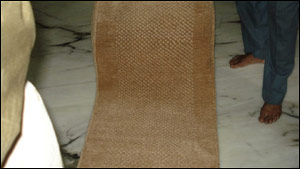Interviews
Parag Handloom survives onslaught of powerlooms
28 Jul '11
5 min read

He also attributes the success of their endeavour to his joint family made up of 70 odd members. Most of the male members are involved in various stages of the handloom business, beginning from doubling and twisting of yarn to weaving to sales.
He uses coarse count cotton yarn as warp and texturised polyester bright yarn for the weft. The designs are developed by members of the joint family who gained from hands-on experience over the years and do not depend on any textile designers.
Pragjibhai admits that they have to change the designs with passing times. Till a few years back, consumers would prefer plain car or sofa coverings. However, today they have become more demanding and he has to provide products with various motifs and designs.
Pragjibhai is also very particular about quality of the products they sell. He takes care that the gray cotton or dyed yarn he purchases is of the best quality, to ensure that the product lasts long and does not fade over a period of time. After the fabric is woven, there are stringent quality checks to ensure that the products that reach the consumers are of the best quality.
He also disapproves the fact that, fabrics made on handlooms are of not as good a quality as those woven from powerlooms. He is of the opinion that handloom fabrics can be woven with higher picks, which gives extra strength to the fabric.
As regards future, he is extremely pessimistic on the availability of handloom workers, considering that the current situation is very bad in itself. He blames the popular government scheme – NRGEA as well as new emerging and other traditional sectors for the shortage of workers in the handloom sector.
He also cannot consider diversifying in to new product categories due to the shortage of workers as he believes that he will have to rope in the existing workers for new categories of products, which can come only at the cost of discarding the current product range.
All the workers currently working in his units have been trained by the family members. But he feels that the Gujarat government should initiate skill development handloom weaving programs across the state in order to attract new recruits in to the sector.
His son, who is pursuing a MBA degree, however has different plans. Looking at the shortage of workers in the handloom sector, he wishes to carry out research to produce the same quality of products on powerlooms.
His other son in the near future intends to explore overseas markets in a bid to expand the business. However, once again the labour shortage is the biggest roadblock coming in the way of fructifying their dreams.
Pragjibhai is of the opinion that, the weaving business runs in their family's blood and genes and the next generation is taking up easily, the various facets of managing and running the handloom business.
He uses coarse count cotton yarn as warp and texturised polyester bright yarn for the weft. The designs are developed by members of the joint family who gained from hands-on experience over the years and do not depend on any textile designers.
Pragjibhai admits that they have to change the designs with passing times. Till a few years back, consumers would prefer plain car or sofa coverings. However, today they have become more demanding and he has to provide products with various motifs and designs.
Pragjibhai is also very particular about quality of the products they sell. He takes care that the gray cotton or dyed yarn he purchases is of the best quality, to ensure that the product lasts long and does not fade over a period of time. After the fabric is woven, there are stringent quality checks to ensure that the products that reach the consumers are of the best quality.
He also disapproves the fact that, fabrics made on handlooms are of not as good a quality as those woven from powerlooms. He is of the opinion that handloom fabrics can be woven with higher picks, which gives extra strength to the fabric.
As regards future, he is extremely pessimistic on the availability of handloom workers, considering that the current situation is very bad in itself. He blames the popular government scheme – NRGEA as well as new emerging and other traditional sectors for the shortage of workers in the handloom sector.
He also cannot consider diversifying in to new product categories due to the shortage of workers as he believes that he will have to rope in the existing workers for new categories of products, which can come only at the cost of discarding the current product range.
All the workers currently working in his units have been trained by the family members. But he feels that the Gujarat government should initiate skill development handloom weaving programs across the state in order to attract new recruits in to the sector.
His son, who is pursuing a MBA degree, however has different plans. Looking at the shortage of workers in the handloom sector, he wishes to carry out research to produce the same quality of products on powerlooms.
His other son in the near future intends to explore overseas markets in a bid to expand the business. However, once again the labour shortage is the biggest roadblock coming in the way of fructifying their dreams.
Pragjibhai is of the opinion that, the weaving business runs in their family's blood and genes and the next generation is taking up easily, the various facets of managing and running the handloom business.
Fibre2fashion News Desk - India
Popular News
Leave your Comments
Editor’s Pick
Folker Stachetzki
Brother Internationale Industriemaschinen GmbH
Susanne Guldager
Label - La Femme Rousse
































-Ltd..jpg?tr=w-120,h-60,c-at_max,cm-pad_resize,bg-ffffff)





.jpg?tr=w-120,h-60,c-at_max,cm-pad_resize,bg-ffffff)
.jpg?tr=w-120,h-60,c-at_max,cm-pad_resize,bg-ffffff)






